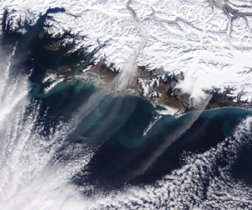Strong northeasterly winds blowing across coastal regions of southern Alaska launched massive clouds of dust over the Gulf of Alaska in mid-March. Most of the material in these plumes is known as rock flour, a fine-grained sediment that glaciers create in prodigious quantities as they grind their way to the sea.

Early melting of snow this year exposed the silty areas, according to NASA. The agency released an image of dust clouds taken by the Terra satellite on March 13. Wind gusts in the area reached nearly 160 kilometers per hour, and stiffer gusts of about 175 km/hour at Anchorage International Airport shut down the facility for about 9 hours on the day the image was captured.
****************
If you have a comment on this article that you would like considered for publication in Science News, send it to editors@sciencenews.org. Please include your name and location.






